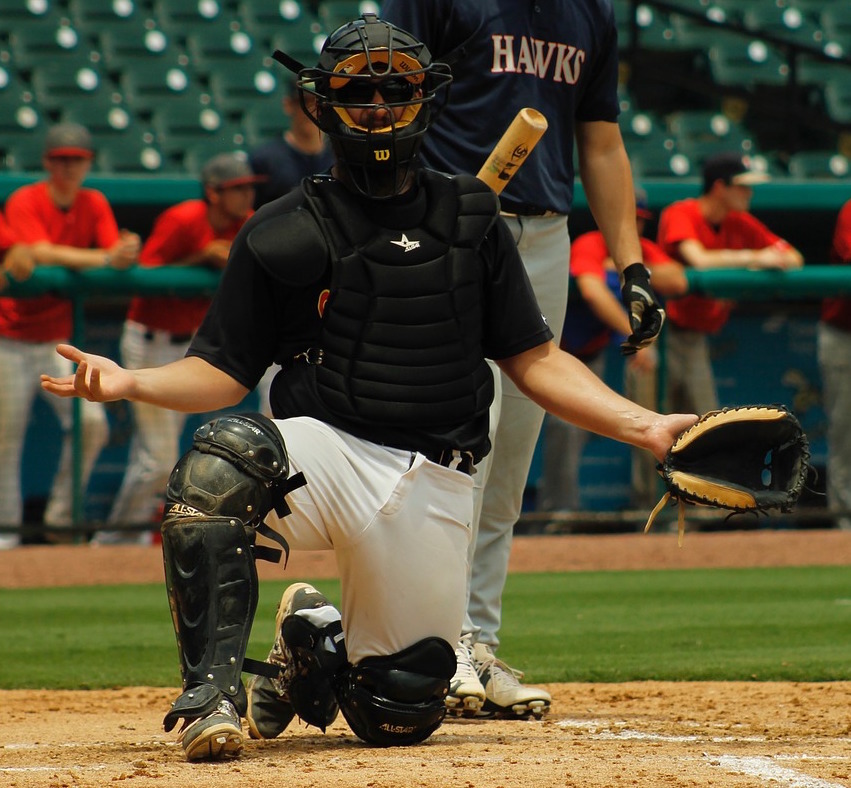Tip for catchers to help their coach on close pitches
August 7, 2017 by Coach McCreary
Filed under Catching, Coaching
 “COME ON, UMP! WHERE’S THAT PITCH? LET’S GO!””
“COME ON, UMP! WHERE’S THAT PITCH? LET’S GO!””
Sit close to a field and you will hear a lot of variations of the phrase above. Quite often, what follows will be the umpire calling time-out, taking his mask off, and telling the coach(es) to pipe down or else they will be watching the rest of the game from the parking lot.
The coach-umpire dynamic can be a tricky one when a coach feels his pitcher is being squeezed on close pitches. Coaches want to say something effective when it is appropriate but not say something on every single close pitch. If they do then the coach is usually seen as just a loud mouth who thinks every pitch his pitcher throws should be a strike and every pitch the opposing team’s pitcher throws should be a ball. Nobody likes those coaches, especially the umpires. The coach also has the problem of not always having the best angle to read the pitch. Coaches often have a better angle than the umpire on high vs low due to their sightline being off to the side of home plate. The umpire, however, has a much better angle than the coach on inside vs outside pitches.
So, how does a coach effectively argue inside/outside pitches if the umpire has a much better view on those pitches?
Answer: Teach your catcher how to properly tell you. They have the same view as the umpire.
The photo at the top of this post is NOT an effective way for a catcher to tell his coach that the umpire just missed the previous pitch. If the catcher does this, he is bound to get an earful from the umpire for showing the umpire up in front of everyone. That’s never a good idea.
The tip for catchers and coaches is to devise a simple covert sign that relays the message “The ump just missed that pitch.“
If the coach is in the dugout to the right of the catcher, the catcher might put his right hand on top of his right knee after the call. If the coach is to the left, he might do something with his glove. Maybe pull a string or shake it in some way. Whatever the sign is, it let’s the coach know in a much more secretive way that the ump just missed that inside or outside pitch.
If a coach thinks a pitch was a strike and his catcher DOES NOT give him the agreed upon sign then the coach keeps his mouth shut. If he gets the sign then the coach is more likely to get a lenient umpire after the comment. The umpire begins to notice that the coach only says something on pitches that arguably should have been called a strike thus giving the coach more credibility in the eyes of the umpire.
Be aware, however, that experienced umpires know that catchers sometimes do this. If you make the sign too obvious or too frequent, the umpire will catch on and will not be pleased. Catchers also need to know that they have to be completely honest in their judgement of pitches. If a pitch legitimately could be called either way by the umpire, the catcher should NOT give the sign! The sign should be reserved for only those pitches that are clearly missed by the umpire.
Getting your message across to an umpire without crossing the line is a difficult balance for a coach. As in the examples above, getting an honest tip from your catcher can be a big help.





I would disagree with your statement that a catcher and umpire have the same view. An umpire should always be setup in the slot which is essentially on the inside corner of the plate. A catcher’s side to side position will vary depend on the intended pitch location. Also, an umpire’s eyes will typically be at or slightly above the top of the strike zone. A catcher’s eyes are typically towards the middle of the zone. These two differences in position location may seem subtle but they can greatly affect one’s determination of pitch location relative to the strike zone.